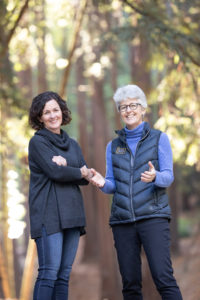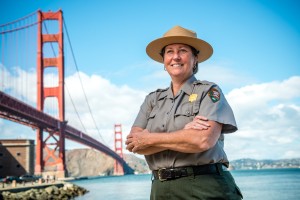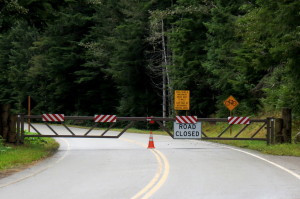On Friday, May 29, the National Park Service and friends of the Golden Gate National Recreation Area (GGNRA) will gather to celebrate the life and legacy of Brian O’Neill, who died from complications due to heart surgery on May 13. Brian was the superintendent of GGNRA for 22 years, and was revered by many for his dedication to getting people out into the park. I spoke with Amy Meyer, author of New Guardians for the Golden Gate: How America Got a Great National Park and founding member of People for a Golden Gate National Recreation Area, a local activist group that advocated for the creation and expansion of a national park centered around the Golden Gate. She knew Brian well.
BN: You’ve known Brian for more than 25 years. How did you first meet?
AM: I’ve been with People for a Golden Gate National Recreation Area for 39 years, but I didn’t know Brian at the beginning although we worked on the same, or at least an intersecting, cause. We were both part of the movement to create national parks in urban areas. I was with People for a GGNRA and he with the Bureau of Outdoor Recreation (BOR). BOR, which is now defunct, was a national office charged with creating and overseeing National Recreation Areas. At the time of the founding of People, Brian was in Washington with BOR. We met after he came to San Francisco in 1981.
BN: What was Brian’s first role with the parks after he came to San Francisco?
AM: He worked with Jack Davis, then superintendent for GGNRA, as his deputy superintendent. Jack had a more traditional vision about national parks; he saw them as big spaces. As they worked together, Brian gradually took over more external jobs, such as working in the field and interfacing with the community, which was unusual for a deputy superintendent.
Then Jack retired and Brian became the superintendent. What was so fantastic was how he embedded himself in the community and got the community to believe in the parks. It used to be that people who worked with parks were different, distant. In fact, before the creation of Golden Gate National Recreation Area, members of the public often preferred state parks because they felt that Sacramento was more relevant. Brian brought home the idea that Washington could be closer than Sacramento. He made sure that the parks were in the community and the community was in the parks.
BN: What made Brian unique as a superintendent?
AM: Brian could remember names and faces after meeting people only once. Since Brian’s death, I’ve heard from many people who valued that skill in him. Last Sunday a maintenance worker for the NPS told me about a time he was working at Ocean Beach and Brian stopped him and asked him about the beach: what he thought of it, what could be improved. The man was amazed not only that Brian asked him about his work, but at how Brian really listened to his answers.
I heard almost the same thing again soon after. As part of the healing process, those of us who knew and worked with Brian have been taking group walks in the parks. I went out on one of these walks and again people stopped me to tell me about a personal interaction with Brian. In one instance, an electrician told me the story of how he had met Brian for the first time at a social event. They talked for a little bit and the next thing he knew, his wife was exchanging frittata recipes with Brian. That’s the kind of person he was–very accessible.
And Brian could always do something with a twinkle, even when it was difficult. Having a sense of humor in the Bay Area is really important. If you are going to be the pompous guy from the federal government, you aren’t going anywhere. He and his twin brother, Alan, still sometimes tried to change places as they did when they were growing up together. Ed Wayburn of the Sierra Club told me a story about being on the receiving end of Brian’s humor. Ed was standing at an ATM on Fillmore and he turned around to find himself facing two Brian O’Neills. He said he felt weak at the knees; he hadn’t known Brian had a twin.
BN: What is the lasting influence of Brian’s work?
AM: There is a major problem in many parks with habitat restoration because the land was used for ranching and army purposes. There is a lot of stuff to clean up still. When new plants are put in, exotic plants need to be pulled. For example, the silver lupine that houses the larvae of and is food for the endangered mission blue butterfly is itself threatened by many non-native species. But the park needs teams of volunteers to help eradicate non-natives. These teams have been encouraged and nourished by Brian. He would go out personally to weed with them.
The park started because of people in the Bay Area, and it is still possible because of them. In Land’s End, my San Francisco neighborhood, my neighbors and friends know the park. They care about it: the trails, the maintenance, and the birds in nesting season. They watch everything. They come together to take care of a relatively small piece of land. That’s Brian’s legacy.
BN: Many view Brian as setting the standard for what parks should be, and what a parks superintendent should be. What are those standards?
AM: First, you need to know that he was part of a tradition of a service that started in 1916. Before anything else, Brian was a thoroughly believing National Park Service member. He truly believed that parks had been set aside for all to experience and appreciate. He did all that and he brought people in, not just so there can be vast acres of land, but also because this is an area that is a people area, and people have to believe that it’s important. He carried these principles, which he knew and believed in from childhood on, in a human way. In other words, he didn’t differ from the tradition of the National Park Service; he took that tradition further, to other people.
BN: The celebration on May 29 is at Crissy Field in the Presidio. Was there somewhere in the GGNRA, Crissy Field or elsewhere, that he especially loved?
AM: Crissy Field is an appropriate place to honor him. The entirety of the reshaping Crissy Field as a vital part of a park was all done on his watch. The other place he loved was Fort Mason, where he could look down from his office on the Great Meadow
BN: Is there anything else you think our readers should know about Brian?
AM: The best way to honor Brian’s memory is to come on out and visit the park.
Brian’s colleagues at the Golden Gate National Parks Conservancy have set up a fund to continue Brian’s efforts to involve youth in conservation and the national park. If you are interested in contributing to the Brian O’Neill Youth Conservation Leader Fund, go to www.incelebrationofbrianoneill.blogspot.com.




